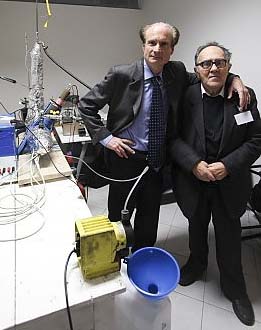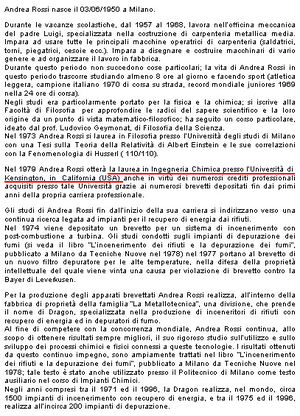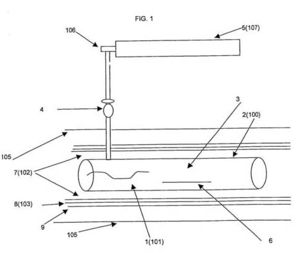Difference between revisions of "Focardi-Rossi Energy-Catalyzer"
m |
|||
| Line 1: | Line 1: | ||
<pre>Article is in translation and unfinished</pre> | <pre>Article is in translation and unfinished</pre> | ||
[[image:Rossi_Focardi.jpg|Andrea Rossi und Sergio Focardi (Bild "La Repubblica")|thumb]] | [[image:Rossi_Focardi.jpg|Andrea Rossi und Sergio Focardi (Bild "La Repubblica")|thumb]] | ||
| − | The '''Rossi Focardi Energy Amplifier''' (also ''E-Cat'' or just ''Rossi energy amplifier'') is allegedly a small fusion reactor assumed to be based on [[Cold Fusion]]. The Italian company EON srl claims to bring it to market in 2011. It is claimed to produce more than 10 kW thermal energy while needing just a couple of 100 Watts of electrical energy to power it. According to the Italian inventors, the professor emeritus in physics Sergio Focardi and the alleged engineer Andrea Rossi<ref>Rossi: ''I am a doctor in the Philosophy of Science and Engineering from the Universita’ Degli Studi Di Milano''</ref> cold fusion <ref>Andrea Rossi in his patent application, Page 12: ''the reaction actually provides a true nuclear cold fusion.''</ref> of hydrogen and nickel to copper is happening in the reactor. As a side-effect of the reaction | + | The '''Rossi Focardi Energy Amplifier''' (also ''E-Cat'' or just ''Rossi energy amplifier'') is allegedly a small fusion reactor assumed to be based on [[Cold Fusion]]. The Italian company EON srl claims to bring it to market in 2011. It is claimed to produce more than 10 kW thermal energy while needing just a couple of 100 Watts of electrical energy to power it. According to the Italian inventors, the professor emeritus in physics Sergio Focardi and the alleged engineer Andrea Rossi<ref>Rossi: ''I am a doctor in the Philosophy of Science and Engineering from the Universita’ Degli Studi Di Milano''</ref> cold fusion <ref>Andrea Rossi in his patent application, Page 12: ''the reaction actually provides a true nuclear cold fusion.''</ref> of hydrogen and nickel to copper is happening in the reactor. As a side-effect of the reaction ionizing radiation should be emitted, but independent measurement during the experiments disproved that.<ref>http://www.psiram.com/doc/Levi%2C_Giuseppe_-_Report_on_heat_production_during_preliminary_tests_on_the_Rossi_Ni-H_reactor_%282010-2011%29.004810.pdf</ref> Attempts to replicate the experiment independently failed so far. The last public presentation was mid-January 2011. |
The true inventor of the principle was the Italian biophysicist Francesco Piantelli in 1989, who filed a patent application on it in 2010.<ref>WO 2010058288 A1: METHOD FOR PRODUCING ENERGY AND APPARATUS THEREFOR. 2010-05-27. Erfinder: PIANTELLI SILVIA; PIANTELLI FRANCESCO</ref> Rossi, who himself tries to patent his invention, does not acknowledge that: | The true inventor of the principle was the Italian biophysicist Francesco Piantelli in 1989, who filed a patent application on it in 2010.<ref>WO 2010058288 A1: METHOD FOR PRODUCING ENERGY AND APPARATUS THEREFOR. 2010-05-27. Erfinder: PIANTELLI SILVIA; PIANTELLI FRANCESCO</ref> Rossi, who himself tries to patent his invention, does not acknowledge that: | ||
| Line 8: | Line 8: | ||
==Purported functional principle== | ==Purported functional principle== | ||
[[image:FAE3.jpg|Andrea Rossi and the reactor (Demonstration an 14. Januar 2011, Source: [http://curiositybox.wordpress.com/2011/01/16/bologna-14111-cronaca-test-fusione-fredda-del-reattore-nichel-idrogeno-focardi-rossi/ Curiosity-Blog])|350px|thumb]] | [[image:FAE3.jpg|Andrea Rossi and the reactor (Demonstration an 14. Januar 2011, Source: [http://curiositybox.wordpress.com/2011/01/16/bologna-14111-cronaca-test-fusione-fredda-del-reattore-nichel-idrogeno-focardi-rossi/ Curiosity-Blog])|350px|thumb]] | ||
| − | + | All currently known information about the "Rossi Focardi Energy Amplifier" come from the inventors, a patent application by Rossi, YouTube videos and statements from a couple of physicists which tried to replicate the principle. There is no noteworthy reception from the international physics community so far and an attempt of the inventors to publish an article about their device in a renowned professional journal failed. Only single physicists reacted with blog entries and comments (e.g.: [http://pages.csam.montclair.edu/~kowalski/cf/388amplifier.html]). As of March 2011 no impeccable scientific publication is known. | |
| − | + | Focardi and Rossi spread their claims through their own "online newspaper" "Journal of Nuclear Physics", basically an Internet blog and the Italian newspaper "Il Cimento". "Journal of Nuclear Physics" was the title of a Russian professional journal, which has been discontinued. The involved company EON srl has not published any information. Physicist Focardi disclosed on inquiry, that the newspaper "Journal of Nuclear Physics" was founded since the attempt to publish in an accredited journal had failed. | |
| − | + | According to available and partly contradicting information from the inventors Focardi and Rossi the small reactor makes exothermal fusion possible. They claim that that they were able to "produce" 130 kW thermal energy in an extreme case and needed just 80 to 1250 Watt to "heat up" and for the operation of the electronic controller. | |
| − | + | The process was unfolded only in part, even though a patent application was filed (not approved currently), involves that nickel and hydrogen are transformed to copper which creates heat and ionizing radiation. In the patent application is more precise and states that the stable nickel isotope 62Ni28 (which makes about 3,6% of normal nickel) reacts with hydrogen and is transformed into the stable copper isotope 62Cu29. The copper that is created through this process is said to consist of two stable copper isotopes with an isotope proportion that is different from natural copper.<ref>According to S. Focardi in an E-Mail: ''[...] mostra l'esistenza di Cu (non presente inizialmente) i cui due isotopi stabili sono in un rapporto diverso da quello naturale [...]''</ref> Such a fusion would need very high temperatures and strong gamma radiation from the destruction of positrons and electrons would be emitted.<ref>According to Prof. Jonghwa Chang, Chief Research Advisor of the "Korea Atomic Energy Research Institute", answer to an inquiry by an Italian chemist. see: [http://www.queryonline.it/2011/01/31/il-ritorno-della-fusione-fredda-2/]</ref> | |
| + | <!-- | ||
Verwendet worden sein sollen anfänglich Nickelstäbe, und bei den letzten Versuchen Nickelpulver (die Rede ist von Partikelgrößen im nm-Bereich, in der Patenschrift werden jedoch 10 µm genannt). Als Lieferant des Nickel nannte Rossi die Mailänder Firma "Gerli Metalli"<ref>Powder nickel: Gerli Metalli--Milan</ref>. Zusätzlich sollen unbekannte, und auch in der Patentanmeldung nicht näher bezeichnete Katalysatoren zum Einsatz kommen. Nach nicht nachprüfbaren Gerüchten aus dem Internet könne es sich dabei um [http://de.wikipedia.org/wiki/Raney-Nickel "Raney-Nickel"] handeln, denn zweimal war es in einem Labor von Rossi zu einem Brand gekommen, der auf "Raney-Nickel" zurück zu führen war. Nickeloxid, das mit Wasserstoff unter Wasserbildung und Wärme reagiert (NiO2 + H2 -xxx-> Ni + H20) soll hier nicht verwendet worden sein. | Verwendet worden sein sollen anfänglich Nickelstäbe, und bei den letzten Versuchen Nickelpulver (die Rede ist von Partikelgrößen im nm-Bereich, in der Patenschrift werden jedoch 10 µm genannt). Als Lieferant des Nickel nannte Rossi die Mailänder Firma "Gerli Metalli"<ref>Powder nickel: Gerli Metalli--Milan</ref>. Zusätzlich sollen unbekannte, und auch in der Patentanmeldung nicht näher bezeichnete Katalysatoren zum Einsatz kommen. Nach nicht nachprüfbaren Gerüchten aus dem Internet könne es sich dabei um [http://de.wikipedia.org/wiki/Raney-Nickel "Raney-Nickel"] handeln, denn zweimal war es in einem Labor von Rossi zu einem Brand gekommen, der auf "Raney-Nickel" zurück zu führen war. Nickeloxid, das mit Wasserstoff unter Wasserbildung und Wärme reagiert (NiO2 + H2 -xxx-> Ni + H20) soll hier nicht verwendet worden sein. | ||
Revision as of 22:23, 11 March 2011
Article is in translation and unfinished
The Rossi Focardi Energy Amplifier (also E-Cat or just Rossi energy amplifier) is allegedly a small fusion reactor assumed to be based on Cold Fusion. The Italian company EON srl claims to bring it to market in 2011. It is claimed to produce more than 10 kW thermal energy while needing just a couple of 100 Watts of electrical energy to power it. According to the Italian inventors, the professor emeritus in physics Sergio Focardi and the alleged engineer Andrea Rossi[1] cold fusion [2] of hydrogen and nickel to copper is happening in the reactor. As a side-effect of the reaction ionizing radiation should be emitted, but independent measurement during the experiments disproved that.[3] Attempts to replicate the experiment independently failed so far. The last public presentation was mid-January 2011.
The true inventor of the principle was the Italian biophysicist Francesco Piantelli in 1989, who filed a patent application on it in 2010.[4] Rossi, who himself tries to patent his invention, does not acknowledge that:
- "My process has nothing to do with the process of Piantelli. The proof is that I am making operating reactors, he is not."
Purported functional principle
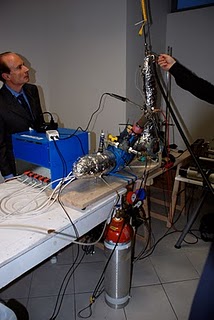
All currently known information about the "Rossi Focardi Energy Amplifier" come from the inventors, a patent application by Rossi, YouTube videos and statements from a couple of physicists which tried to replicate the principle. There is no noteworthy reception from the international physics community so far and an attempt of the inventors to publish an article about their device in a renowned professional journal failed. Only single physicists reacted with blog entries and comments (e.g.: [3]). As of March 2011 no impeccable scientific publication is known. Focardi and Rossi spread their claims through their own "online newspaper" "Journal of Nuclear Physics", basically an Internet blog and the Italian newspaper "Il Cimento". "Journal of Nuclear Physics" was the title of a Russian professional journal, which has been discontinued. The involved company EON srl has not published any information. Physicist Focardi disclosed on inquiry, that the newspaper "Journal of Nuclear Physics" was founded since the attempt to publish in an accredited journal had failed.
According to available and partly contradicting information from the inventors Focardi and Rossi the small reactor makes exothermal fusion possible. They claim that that they were able to "produce" 130 kW thermal energy in an extreme case and needed just 80 to 1250 Watt to "heat up" and for the operation of the electronic controller.
The process was unfolded only in part, even though a patent application was filed (not approved currently), involves that nickel and hydrogen are transformed to copper which creates heat and ionizing radiation. In the patent application is more precise and states that the stable nickel isotope 62Ni28 (which makes about 3,6% of normal nickel) reacts with hydrogen and is transformed into the stable copper isotope 62Cu29. The copper that is created through this process is said to consist of two stable copper isotopes with an isotope proportion that is different from natural copper.[5] Such a fusion would need very high temperatures and strong gamma radiation from the destruction of positrons and electrons would be emitted.[6]
Application and success claims
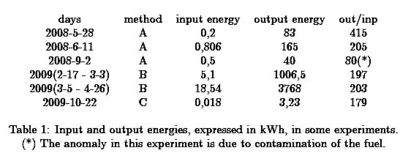
History
Presentation on 14. January 2011
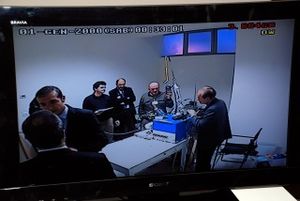
Attempts to replicate the experiments
Inventor Andrea Rossi
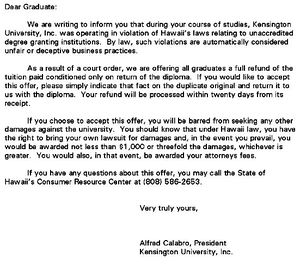
EON srl, Leonardo Corporation and Defkalion Green Technologies
Patents and patent applications
Literature
- Giuseppe Levi: "Report on heat production during preliminary tests on the Rossi “Ni-H” reactor", Univ. Bologna, Jan. 2011 (auch: [4])
- "Italian scientists claim to have demonstrated cold fusion", Physorg, 20.1.2011
- "Il ritorno della fusione fredda", Artikel in der Zeitschrift "Query", 31.1.2011
- "Il ritorno della fusione fredda: ci risponde Levi", Artikel in der Zeitschrift "Query", 2.2.2011
- Focardi S., Habel R., and Piantelli F., "Anomalous Heat Production in Ni-H Systems," Nuovo Cimento, Vol. 107A, p. 163-167, (1994)
- Notoya, R. et al., "Tritium Generation and Large Excess Heat Evolution by Electrolysis in Light and Heavy Water-Potassium Carbonate Solutions With Nickel Electrodes," Fusion Technology, Vol. 26, p. 179, (Sept. 1994)
- Cerron-Zeballos, E., Crotty, I., Hatzifotiadou, D., Lamas Valverde, J., Williams, M.C.S., and Zibichi, A., "Investigation of Anomalous Heat Production in Ni-H Systems," Nuovo Cimento, Vol. 109A, p. 1645-1654, (1996)
- Mengoli, G., Bernardini, M., Manducchi, C., and Zannoni, G., "Anomalous Heat Effects Correlated With Electrochemical Hydriding of Nickel," Il Nuovo Cimento, Vol. 20 D, p. 331-352, (1998)
- Battaglia, A., Daddi, L., Focardi, S., Gabbani, V., Montalbano, V., Piantelli, F., Sona, P.G., and nesi, S., "Neutron Emission in Ni-H Systems," Nuovo Cimento, Vol. 112 A p. 921-931, (Sept. 1999)
- S. Focardi, V. Gabbani, V. Montalbano, F. Piantelli, S. Veronesi. "Large excess heat production in Ni-H systems". Il Nuovo Cimento Vol. 111 A, N.11 pp. 1233, novembre 1998
- Cerron-Zeballos, E., Crotty, I., Hatzifotiadou, D., Lamas Valverde, J., Williams, M.C.S., and Zichichi, A., "Investigation of Anomalous Heat Production in Ni-H Systems". Nuovo Cimento, Vol. 109A, p. 1645-1654, (1996).
- Adalberto Piazzoli. "Fusione Fredda? Una ricerca italiana". CICAP - Scienza & Paranormale N. 78 (Mai 2008)
News
- Franco, Foresta Martin, "Siena scopre l' energia pulita Fusione fredda all' italiana?," Corriere Della Sera, 19. Februar 1994
- Ilaria Venturi: Fusione nucleare a freddo - "A Bologna ci siamo riusciti", Artikel in "La Repubblica" (Bologna-Lokalausgabe) vom 14.1.2011. [5]
Weblinks
- Internetseite von Andrea Rossi
- "Journal of Nuclear Physics". Der Titel suggeriert eine physikalische Zeitschrift, tatsächlich handelt es sich um eine von Focardi und Rossi betriebene, Blog-ähnliche Internetseite, deren Beiträge aber angeblich einen Peer Review durchlaufen und von "mindestens einem" Physikprofessor begutachtet würden.
- http://www.eonsrl.com (aktuell ohne Inhalt)
- http://pages.csam.montclair.edu/~kowalski/cf/388amplifier.html
- http://www.newenergytimes.com/v2/news/2008/NET29-8dd54geg.shtml
References
- ↑ Rossi: I am a doctor in the Philosophy of Science and Engineering from the Universita’ Degli Studi Di Milano
- ↑ Andrea Rossi in his patent application, Page 12: the reaction actually provides a true nuclear cold fusion.
- ↑ http://www.psiram.com/doc/Levi%2C_Giuseppe_-_Report_on_heat_production_during_preliminary_tests_on_the_Rossi_Ni-H_reactor_%282010-2011%29.004810.pdf
- ↑ WO 2010058288 A1: METHOD FOR PRODUCING ENERGY AND APPARATUS THEREFOR. 2010-05-27. Erfinder: PIANTELLI SILVIA; PIANTELLI FRANCESCO
- ↑ According to S. Focardi in an E-Mail: [...] mostra l'esistenza di Cu (non presente inizialmente) i cui due isotopi stabili sono in un rapporto diverso da quello naturale [...]
- ↑ According to Prof. Jonghwa Chang, Chief Research Advisor of the "Korea Atomic Energy Research Institute", answer to an inquiry by an Italian chemist. see: [1]
- ↑ S. Focardi, A. Rossi: A new energy source from nuclear fusion., journal og nuclear physics. [2]
